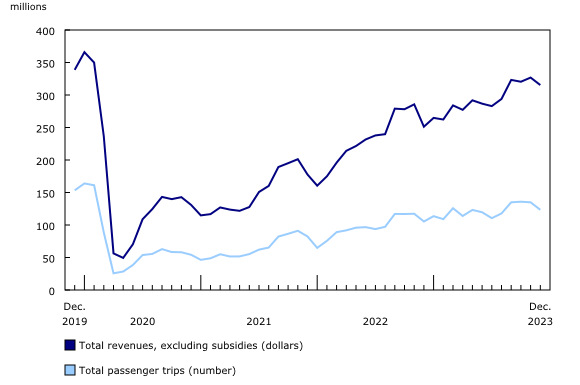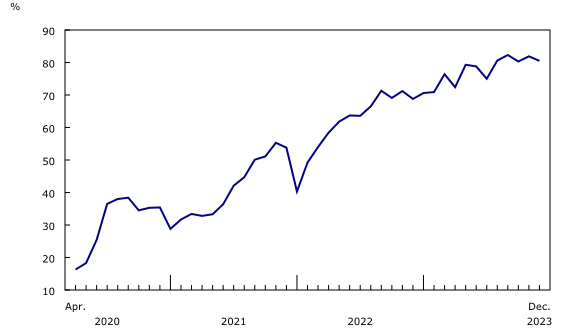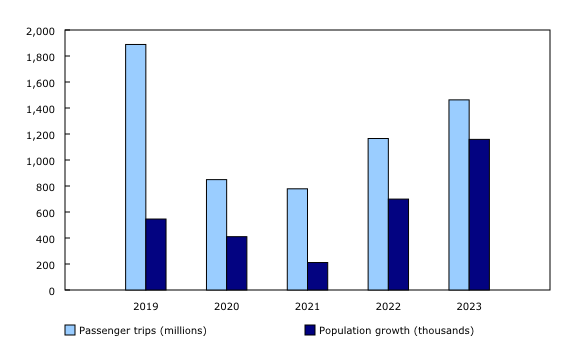Urban public transit, December 2023
Released: 2024-02-20
Highlights
In December 2023, urban transit ridership in Canada reached 123.4 million trips, recovering more than 80% of its December 2019 level, pre-COVID-19 pandemic.
In 2023, there were roughly 1.5 billion total passenger trips taken, up from the 1.2 billion trips recorded in 2022 but representing 77.4% of the 2019 total.
Ridership remains steady
Canada's transit agencies provided 123.4 million passenger trips in December 2023, up 17.1% (+18.0 million trips) compared with the same month in 2022. Although growth has been steady, volumes continue to lag pre-pandemic levels, as there were almost 30 million fewer passenger trips in December 2023 compared with December 2019.
Finances improving
In December 2023, transit agency operating revenue (excluding subsidies) was up 25.5% (+$64.1 million) from the same month in 2022 but was $23.4 million below the December 2019 revenue.
Urban public transit: Year in review, 2023
Recovery since pandemic
The pandemic's impact on urban transit was profound. Before the pandemic, annual ridership approached 1.9 billion trips in 2019. With the public health measures implemented to combat the contagion, ridership fell to 849.1 million in 2020 and then to 778.4 million in 2021, less than half (45.0% and 41.2% respectively) of the 2019 total.
Building on the recovery that started in the second half of 2021 and following a brief pause due to the Omicron variant in January 2022, ridership grew in 2022 to 1.2 billion passenger trips. Growth continued into 2023, with the monthly rate of recovery compared with the same month in 2019 increasing from 70.6% in January to 80.5% in December.
However, this recovery rate does not signal a return to pre-pandemic days for urban transit as Canada's population surpassed 40 million people as of July 1, 2023—an increase of almost 1.2 million from July 1, 2022, and marking the highest population growth since 1957. Unlike the natural increase in 1957, almost 98% of the growth from July 1, 2022, came from net international migration.
Although most pre-pandemic activities have resumed, transit ridership continues to lag, as there were 426.3 million fewer passenger trips in 2023 compared with 2019. Over this same period, Canada's population grew by almost 2.5 million people. With international migration accounting for much of this growth, most of it was concentrated in larger cities with mass transit.
The pandemic has altered commuting behaviour. While most workers have been required to return to the physical workplace, many are using a hybrid arrangement. A recent study on working from home and public transit attempted to quantify the impact of working from home on the reduction in transit passenger trips.
Overall, there remains some uncertainty as to whether urban activities and commuting will return to pre-pandemic patterns.
Did you know we have a mobile app?
Get timely access to data right at your fingertips by downloading the StatsCAN app, available for free on the App Store and on Google Play.
Note to readers
Statistics Canada is publishing more detail from the Monthly Passenger Bus and Urban Transit Survey. The new table 23-10-0307-01—Passenger bus and urban transit statistics, by urban transit agency—includes operating revenue and ridership at the city level for selected transit agencies. Statistics Canada appreciates the cooperation of the 15 transit agencies in making this information available to Canadians.
Survey data are revised on a monthly basis to reflect new information.
The data in this release are not seasonally adjusted.
This survey collects data on operating revenue (excluding subsidies) and the number of passenger trips from a panel of urban transit companies that represents at least 75% of revenue in each province and territory. Note that the panel is adjusted annually to maintain the 75% coverage and could differ slightly from what it was in the same month the previous year.
One-time payments from secondary and post-secondary institutions for academic-year student passes are typically reported as revenue during the early fall and early winter months.
Data before January 2017 can be found in table 23-10-0078-01.
Random tabular adjustment
The random tabular adjustment (RTA) technique, which aims to increase the amount of data made available to users while protecting the confidentiality of respondents, was applied to the totals of the Monthly Passenger Bus and Urban Transit Survey.
Using RTA, Statistics Canada identifies sensitive data and randomly adjusts values rather than suppressing them. The size of the adjustment is calculated to protect respondent confidentiality.
For more information on RTA, please refer to the article "Random Tabular Adjustment is here!," now available as part of the StatCan Blog.
The Transportation Data and Information Hub, a web portal developed jointly by Statistics Canada and Transport Canada, provides Canadians with online access to comprehensive statistics and measures on the country's transportation sector.
Contact information
For more information, or to enquire about the concepts, methods or data quality of this release, contact us (toll-free 1-800-263-1136; 514-283-8300; infostats@statcan.gc.ca) or Media Relations (statcan.mediahotline-ligneinfomedias.statcan@statcan.gc.ca).
- Date modified:




